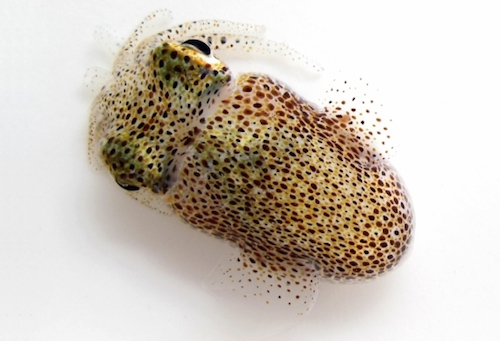 Evolution
Evolution
 Intelligent Design
Intelligent Design
Surprise, Surprise! Bioluminescent Organs in Different Squid Species Suggest Convergent Genetic Evolution

As I noted in a recent post, Lee Spetner’s new book The Evolution Revolution: Why Thinking People Are Rethinking the Theory of Evolution compellingly argues that convergent evolution challenges neo-Darwinian evolution. Why? Because it shows how the same structures may appear over and over again in separate lineages, which is an unlikely pattern if evolution really is an undirected neo-Darwinian process.
A new article at Science Daily, “Let there be light: Evolution of complex bioluminescent traits may be predictable,” provides additional fascinating commentary on the subject, focusing on the independent origin of bioluminescent organs, called photophores, in two species of squid. According to the article, “while they [the photophores] evolved separately, they did so in a remarkably similar manner.” In fact, these similar bioluminescent organs are a striking case of biochemical convergent evolution:
They [the researchers] chose to work with the Hawaiian bobtail squid (Euprymna scolopes) and the swordtip squid (Uroteuthis edulis), a Japanese species used for sushi. These distantly related species are two of five genera known to have bioluminescent organs called photophores. The photophores contain symbiotic, light-emitting bacteria, and the squid are capable of controlling the aperture of their organ to modulate how much light is produced.
The scientists wanted to know how similar the two species’ photophores are in terms of their genetic makeup. To find the answer, they sequenced all of the genes expressed in these light organs, something that could not be done using older sequencing technology.
“They are much more similar than we expected in terms of their genetic makeup,” Oakley said. “Usually when two complicated organs evolve separately we would expect them to take very different evolutionary paths to arrive where they are today. The unexpectedly similar genetic makeup demonstrates that these two squid species took very similar paths to evolve these traits.
More specifically, the researchers demonstrated that bioluminescent organs originated repeatedly during squid evolution and then showed that the global gene expression profiles (transcriptomes) underlying those organs are strikingly — even predictably — similar.
But what are the odds that the same complex trait would evolve multiple times — and develop similar genetic mechanisms convergently? UC Santa Barbara professor Todd Oakley explains:
The probability of complex organs evolving multiple times with similar trajectories should be vanishingly small, noted Oakley. Yet the team’s novel bioinformatic approaches indicate the evolution of convergent phenotypes is associated with the convergent expression of thousands of genes.
So apparently the improbable happened over and over, and over and over, and over and over again — thousands of times. Their reaction? As the technical paper in PNAS puts it, “surprise”:
Surprisingly … the overall gene expression distance between photophores is indistinguishable from the distance between expression levels of any homologous organ of the two species, on average. … Nonmetric multidimensional scaling of the 36 libraries revealed surprisingly close clustering not only within homologous tissue types but also within nonhomologous photophores … This origin of a photophore by amalgamation may have occurred at least two times during the history of squid in surprisingly similar ways, leading to predictable similarity in gene expression. … convergent photophores is surprising because of the expectation for convergent traits to evolve by distinct genetic mechanisms. The finding of widespread coincident changes in convergent photophores indicates that transcriptome evolution in complex novelties may be more predictable than previously suspected.
(M. Sabrina Pankey, Vladimir N. Minin, Greg C. Imholte, Marc A. Suchardd, and Todd H. Oakley, “Predictable transcriptome evolution in the convergent and complex bioluminescent organs of squid,” Proceedings of the National Academy of Sciences, October 21, 2014, doi: 10.1073/pnas.1416574111 (emphases added).)
But once you admit common design into your explanatory toolkit, the prospect that similar genetic mechanisms would be used in different species isn’t so “surprising” at all.
Image credit: Hawaiian bobtail squid (Euprymna scolopes)/Sabrina Pankey, UC Santa Barbara.
